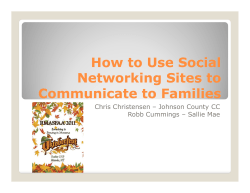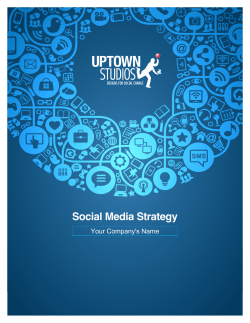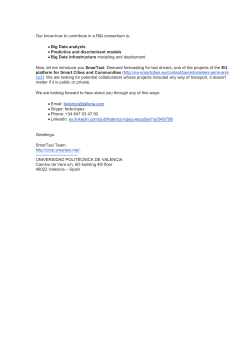
10-minute guide on How To Approach Social Media
10-minute guide on How To Approach Social Media Digital Marketing “Social media is an area that you cannot always control, and you need to have a strategy and plan when using it” Social Media can be defined as “media for social interaction, using highly accessible and scalable communication techniques. Social media is the use of web‐based and mobile technologies to turn communication into interactive dialogue”. If you are considering to engage in any Social Media marketing activity you need to ensure that it is forming part of an overall plan and communications strategy. Otherwise the effort you put into it may be wasted. This 10 minute guide will provide a brief outline on which types of Social Media exist and how to approach Social Media in general. There is a wide variety of Social Media but some of the best known that you at least should know of are: Linkedin is the world’s largest professional network with more than 135 million members in over 200 countries. LinkedIn connects you to your trusted contacts and helps you exchange knowledge, ideas, and opportunities with a broader network of professionals. Facebook is the most popular social network in the world. It’s mainly used for ‘social’ purposes but increasingly, businesses are using it to promote their brands and connect with customers on a more personal level. Facebook contacts are called ‘friends’, with whom you can chat, send messages or post a comment publicly on their personal home page or ‘wall’. Facebook has more than 800 million active users worldwide and 2 million in Ireland alone. Twitter, an online social networking service and microblogging service that enables its users to send and read text‐based posts of up to 140 characters, known as "tweets", with 300 million users as of 2011 generating over 300 million tweets and handling over 1.6 billion search queries per day. YouTube is a video‐sharing website on which users can upload, view and share videos. 48 hours of video are uploaded every minute, resulting in nearly 8 years of content uploaded every day, and over 3 billion videos viewed a day. 10-minute guide on How To Approach Social Media Digital Marketing Relevance Following the economic recession the perception investors have about financial services providers is affected, leading to lower levels of trust. Therefore there is a huge opportunity for you as a broker to be more proactive and dynamic with your customer interactions, with social media being one of the key new age media channels. The use of social media provides an opportunity to increase client communication, add ‘touchpoints’, and increase client ‘stickiness’ (retention). Furthermore, social media tools give new modes for prospecting and measuring influence. Financial advisors who have not taken the initial steps in developing a social media strategy run the risk of losing their relevance. Here are some facts you may not be aware of: Financial services use of social media for business (U.S. surveys) • 61% using Linkedin acquired a client through it (Hubspot 2011) • 40% using Twitter acquired a client through it (Hubspot 2011) • 35% using Facebook acquired a client through it (Hubspot 2011) • 47% using a blog acquired a client through it (Hubspot 2011) • 36% using social networks acquired new clients through it (Socialware 2010) Considerations However, if you are considering to engage in any Social Media marketing activity you need to ensure that it is forming part of an overall plan and communications strategy. Otherwise the effort you put into it may be wasted. Therefore the following considerations need to be taken into account. Firstly, you must be aware that if you are engaging in social media activity that it is an area that you cannot always control and need to be careful when using it as a communication tool. All comments made, both by yourself and customers/followers, are in the public domain and once said cannot be taken back. An unhappy customer comment will stick and you need to be aware that this can happen and either have a plan for how to deal with it or be happy that it’s something that you can manage. Secondly, you need to understand where these media channels sit within your overall communications schedule. They need to tie in with all of your activity otherwise they are not working as hard as possible and achieving maximum impact. These media channels should complement a good marketing strategy but will not take over as a main communication channel unless there is a very good reason behind it and a suitable resource allocated. Objectives & Target Audience Online and social media can be good platforms for raising general awareness levels of your brokerage, however you need to clarify what your specific objectives are and who you are targeting. You run the risk of wasting your time by engaging in Facebook, Twitter, LinkedIn, etc if you are not sure what you wish to achieve from it and who you are trying to talk to. In addition, the tone and messages of your communications should be tailored to your target audience. 10-minute guide on How To Approach Social Media Digital Marketing Resource Another important consideration is resources. Before engaging in social media, you should consider how much time and money you are willing and able to allocate to online and social media. If you only have an hour a week then this will affect your strategy. If you feel that you can give it more time then you may be able to achieve a little more. You might start off with a couple of hours a week and take it from there if you are not sure. Listen & Learn A good place to start is to listen to what others in like‐minded businesses are doing and saying online and in the social media space. Start following them and see what is working for them and how they are doing it. Learn from them. Then decide if you think this is right for your business. Focus The nature of the products sold in the financial services industry often requires face to face interaction and reassurance. There may be an opportunity for you to engage with your local community through social media if you have a clear focus and know what you are trying to achieve and who you are trying to talk to. But as mentioned above, you need to be aware of the pitfalls especially that you cannot control what public comments are put on your pages and you need to ensure that you know how to handle them. Anything you place online should be treated as a legally binding document so any updates you provide on social media should only contain information you are happy to stand over. Consider putting together a communication schedule of information that you wish to post online so you do not find yourself struggling for content and ideas. These updates should reflect your overall communications schedule. i.e., your website and Facebook are other avenues to communicate a message. If you feel that Facebook, Linkedin, or Twitter is something you want to put time into then keep experimenting with what gets the most comments, pageviews and interaction ie. Photos or product updates. Hopefully this guide helps you to understand more aspects of social media‐ even the downsides. The pitfalls are important to know in order to decide if it's really right for your business. Despite its huge potential you should just be careful before you decide to spend your time trying to engage customers through social media if it’s not something that ultimately is going to be the best use of your time. References www.linkedin.com www.facebook.com www.twitter.com www.youtube.com
© Copyright 2025





















